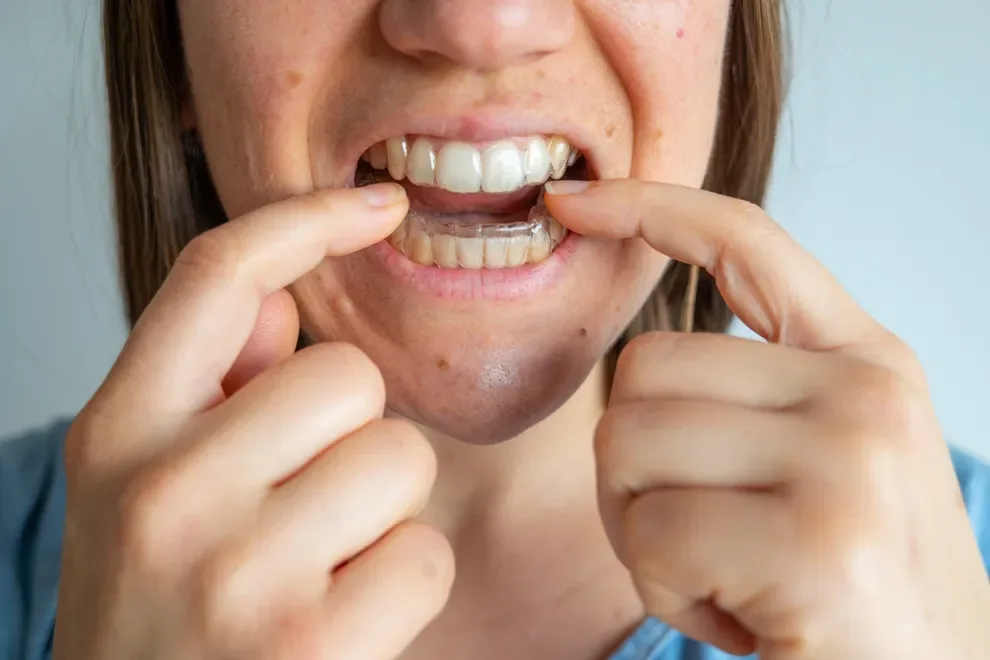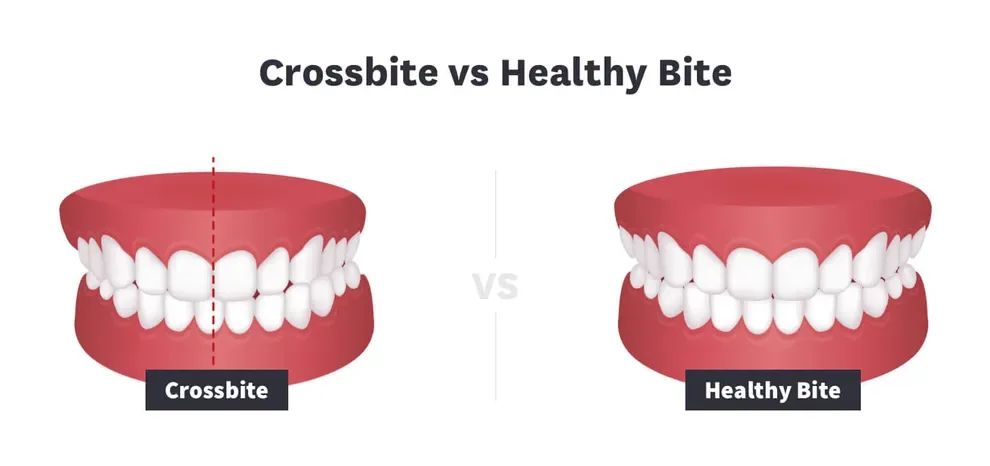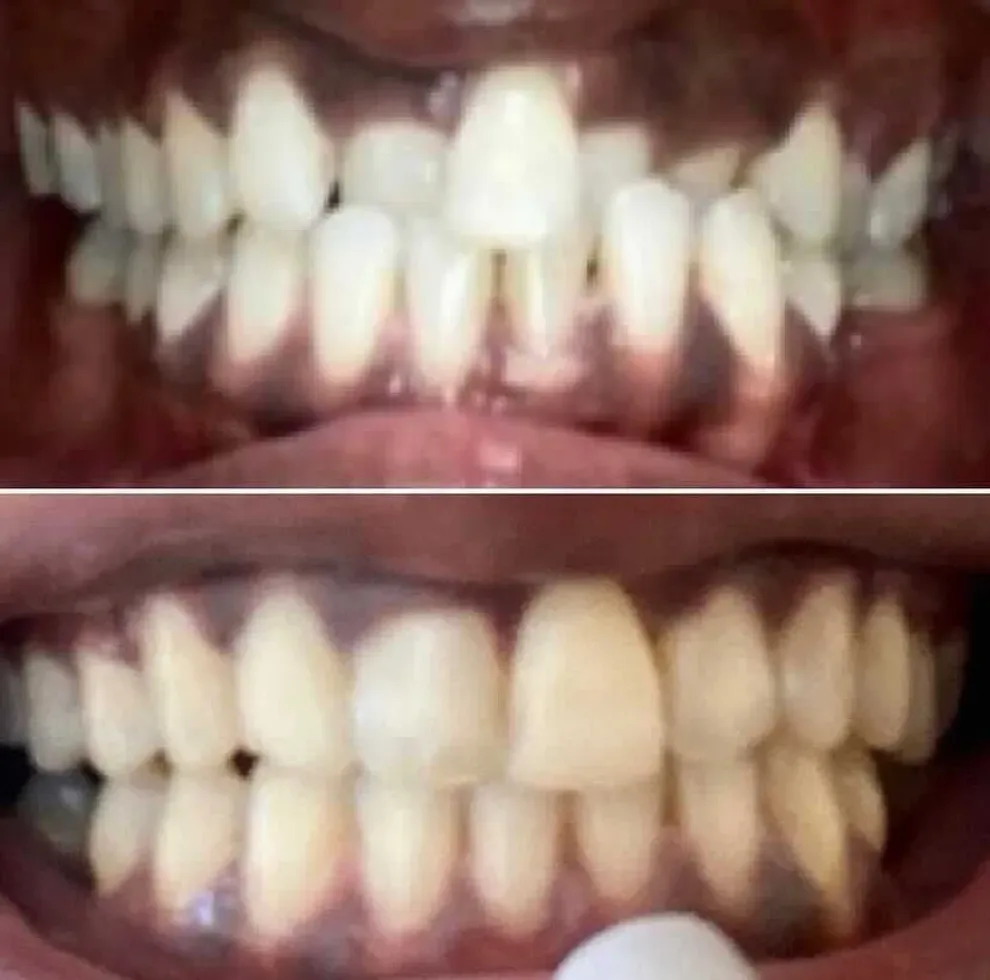Fixing a Crossbite: You Don't Always Need Braces

Table of Contents
- Key Facts about Fixing Crossbite
- What is a Crossbite?
- Types of Crossbites
- How are Crossbites Corrected?
- What Causes Crossbite?
- What Happens If You Do Not Fix It?
- Treat Crossbites Early
- How Braces Work
- Ongoing Dental Treatment
Crossbites are a common orthodontic problem that can affect not only your appearance, but also your day-to-day life and oral and overall health. Fortunately, today’s advanced dental technologies make it easier than ever before to correct bite issues at any age.
How your crossbite is treated will depend on the severity and complexity of the problem. Jaw surgery or tooth extraction may be required in extreme cases, but this is rare. Many people with crossbites can correct them with braces treatment, sometimes with the help of special orthodontic appliances like a palatal expander.
Those with a mild-to-moderate crossbite may opt for the convenience and speed of clear aligner treatment.
Key Facts about Fixing Crossbite
A crossbite is a type of malocclusion (teeth misalignment) that occurs when the upper teeth fit inside the lower teeth.
Living with a crossbite can cause difficulty in performing an effective daily hygiene routine, and it may affect your appearance, eating, and speech.
If left untreated, crossbite can create health problems that include decay and gum disease, TMJ disorder, and sleep apnea.
Treatment options for a crossbite include braces, clear aligners, and orthodontic devices. In severe cases of crossbite, jaw or mouth surgery may be needed.
What is a Crossbite?
A crossbite is a type of malocclusion, or misalignment of the teeth or jaw.
With a healthy bite, your upper teeth should fit just slightly over your lower teeth, with the points of the molars fitting into the grooves of the opposite molar. With a crossbite, the upper teeth sit inside of the lower teeth.
This can affect the alignment of the entire mouth and cause problems with a single tooth, multiple teeth, or a whole group of teeth (for example, molars).
Malocclusions
A crossbite is a type of malocclusion, which is essentially a bite problem. Other types of malocclusions include underbites, overbites, and open bites.
Malocclusions can lead to a variety of long-term issues, such as tooth decay, gum disease, losing teeth, breathing issues, and jaw and head pain.
Crossbite vs. Other Malocclusions
Other types of malocclusions, like overbites and underbites, are more common than crossbites.
With an overbite, the top teeth rest farther forward than they should. This is the most common type of malocclusion, particularly in children. With an underbite, the top teeth rest farther back than they should.
With a crossbite, the upper and lower teeth don’t fit together as they should. There is more variation in how a crossbite manifests, as the issue might be related to tooth placement or jaw alignment. At least one upper tooth is generally inside the lower teeth line with a crossbite.

Types of Crossbites
There are two basic types of crossbite.
Anterior crossbite: When one or more of the top teeth sit behind the bottom teeth. This is specifically a misalignment of your teeth and not of your jaw, which is an overbite.
Posterior crossbite: When the back upper teeth sit inside the back, bottom teeth.
Between 1 and 16 percent of children develop a posterior crossbite, and between 4 and 5 percent develop an anterior crossbite, before their permanent teeth come in. As their adult teeth erupt, a pediatric dentist can start to add orthodontic appliances to their changing mouths, keeping jaws aligned, improving jaw shape, and straightening teeth.
However, many people experience changes in their oral alignment as they get older, even if they had braces as a child. This is due to genetics more than anything else. Adults may need to revisit orthodontics a few times throughout the course of their lives, and this is totally normal.
Crossbites are a problem involving a smaller jaw and misaligned teeth, and they may take special orthodontic devices to correct, but part of that treatment may involve at-home clear aligners
Symptoms of Crossbite
The easiest way to identify a crossbite is visually, and you’ll need confirmation from a dental professional, like a dentist or orthodontist. You might also notice these symptoms:
Jaw pain
Intense headaches
Pain in a tooth or multiple teeth
Upper and lower teeth unable to touch each other
Biting the tongue or inner cheek when speaking or eating
Tooth wear and enamel deterioration
Asymmetrical facial features
Receding gum line
Loose teeth
How are Crossbites Corrected?
Treatment for crossbite will depend on how severe your case of crossbite is, how complex your overall orthodontic issues are, and what’s causing them.
Treatment options for a crossbite include the following:
Headgear is a general term used for dental appliances that influence the development of your mouth and jaw. Because a crossbite involves the jaw, headgear (usually a device with wires that go both inside and outside of the mouth) may be used to help correct the issue.Headgear is usually used for the treatment of childhood and adolescent orthodontic problems, as the jaws of adults are already developed and harder to manipulate.
This dental device is used to widen the upper jaw. After being placed on the roof of the mouth, it expands to move the sides of your jawbone apart. This can help a crossbite by providing the width to the upper jaw that would allow the upper teeth to sit slightly over the lower teeth, as it would in a natural aligned bite.
Procedures like bonding, crowns, reshaping, and veneers can improve the appearance of teeth in some cases and help with very minor orthodontic issues like a small space between two teeth. This won’t address the underlying orthodontic issue, however, and teeth may shift over time.
For more severe overbites with crowding, tooth removal may be needed to provide space for teeth to shift into correct positioning.
Brackets are cemented to teeth and connected by bands and wires. The wires are tightened to apply pressure to move teeth into correct alignment.
Braces are a common treatment for crossbite. For severe cases, they may be used in conjunction with headgear or a palatal expander, or after extraction or surgery.
After an impression or image of your current teeth and bite is taken, specialists and software create a series of clear and removable aligners. These aligners fit over your teeth but have subtle changes that apply gentle continuous pressure and guide tooth movement.
Each aligner tray is worn for a week or two before moving on to the next tray, progressively shifting your teeth into place.
What Causes Crossbite?
Many cases of crossbite (and all malocclusion) are caused by genetics or an inherited jaw or misalignment condition.
Other causes of crossbite include the following:
Teeth that are too large in relation to the jaw, resulting in misalignment
Continuous thumb or finger sucking as a baby or child (especially past the age of 5)
Use of certain types of sippy cups as a child
Teeth shifting after loss of a tooth
Jaw or mouth injury

What Happens If You Don't Treat a Crossbite?
For those who have left a crossbite untreated since childhood, treatment may seem unnecessary, especially if it seems only the back (less visible) teeth are affected.
Others may not even realize they have a crossbite. Teeth may have shifted with age, or after a tooth loss or injury. Some may feel self-conscious about their crossbite, but they don’t want to deal with having to wear braces.
To understand the potential impact of a crossbite, consider the following:
Malocclusions (including crossbite) can cause crowding and spacing issues. This can make it difficult to clean in between the teeth and can create hidden “pockets” where problematic bacteria and food particles can accumulate, causing decay and gum problems.
Teeth misalignment can result in tooth friction and wear on enamel, weakening tooth structure and increasing the risk of tooth damage and loss.
A crossbite can put unnatural stress and wear on the jaw, causing muscle and structural problems.
A crossbite can affect your daily life, affecting your speech and eating habits.
A crossbite can hinder your mental health, making you feel insecure about your smile or speech in social or public settings.
These are potential problems of untreated crossbites:
The jaw shifting to one side, causing muscle strain, chewing problems, and an uneven facial appearance
Lopsided growth of the jaw in children, leading to uneven pressure on the teeth, which can cause tooth decay and loss later in life
Wearing down of tooth enamel on one side, causing cracking or a higher risk of cavities
Tooth decay, gingivitis, and periodontitis
Tooth loss from damage or decay
TMJ or teeth grinding, leading to muscle pain and headaches
Pain and muscle tension in other areas, including the shoulders and neck
Sleep apnea or snoring that disrupts sleep, which can increase the risk of other health issues, including heart disease or diabetes
Trouble speaking clearly
Difficulty biting into food or chewing well, which increases the risk of digestive issues, diabetes, and heart problems
Bad breath
Even small changes in the alignment of your teeth can increase your risk of oral health problems. In children, crossbites are easier to fix because the jaw is still growing. Adult crossbites can develop and get worse over time, but they can still be addressed by orthodontics.
Treat Crossbites Early
Small crossbites may not cause immediate problems, but it is best to talk to your dentist if you are concerned. In general, it is better to get treatment for crossbites than to ignore them.
It is important to treat crossbites early, so you can avoid serious oral health problems later. Ongoing damage to your oral health can make the crossbite worse, along with other issues.
Getting clear aligner treatment early can improve your smile overall — not just the appearance of your front teeth but also the health of your back teeth. You will not only look great but also feel great, knowing your appearance translates to better physical health overall.
How Braces Fix Crossbites
Braces are effective in treating many cases of crossbite. For some serious bite problems, braces are needed as part of treatment.
Because braces consist of brackets that are cemented to teeth and connected by wires that are tightened regularly by your orthodontist, a very custom treatment plan can be designed to address even very severe cases of overbite.
Depending on the complexity and severity of the crossbite, braces treatment may include the following:
A tooth extraction or jaw surgery before braces are put on: If crowding requires tooth removal or if there’s a structural jaw issue that requires surgery before the teeth can be aligned, these procedures will be performed before braces treatment.
Long-term care: For those with a substantial crossbite, treatment may take two years or longer.
Additional orthodontic devices: Headgear may be used to guide jaw growth. A palate expander may be prescribed to move the teeth, change the shape of the jaw, and hold the teeth in a more permanent and improved position.
Retainers: These are often used to hold the teeth in the corrected position after braces are off.
Braces are a more intensive and invasive treatment, often with long-term results, for crossbite correction.
Braces can be a more permanent fix, but they are not always necessary for mild cases of crossbite. When the crossbite is less significant, treatment plans using a removable expander and/or aligners can be sufficient.
Ongoing Dental Treatment after your Crossbite is Fixed
The more intensive procedures to treat a crossbite are intended to be permanent or at least last for many years. In fact, the treatment plan itself may take a couple years to complete.
The more intensive procedures to treat a crossbite are intended to be permanent or at least last for many years. Low-impact treatments may expand your jaw, but they may not prevent your teeth from moving around later in life. You could still need aligners at some point, even after crossbite treatment.
If you find that your teeth have moved again, you likely feel frustrated. Fortunately, there are better solutions available today to improve your teeth alignment.
You do not even have to go to an orthodontist to get straight teeth. With doctor-monitored, at-home aligners, you can make impressions of your teeth and palate at home to determine if you’re a candidate for aligner treatment. If you are, continue with the treatment plan and receive a full set of aligners to get you to your optimal bite and smile.
Unlike braces, aligners are clear, removable, and fast. Often, at-home aligner treatment does not take longer than six months, making it a great option for people who have mild or moderate crowding, bite issues, crooked teeth, or gaps in their teeth.
